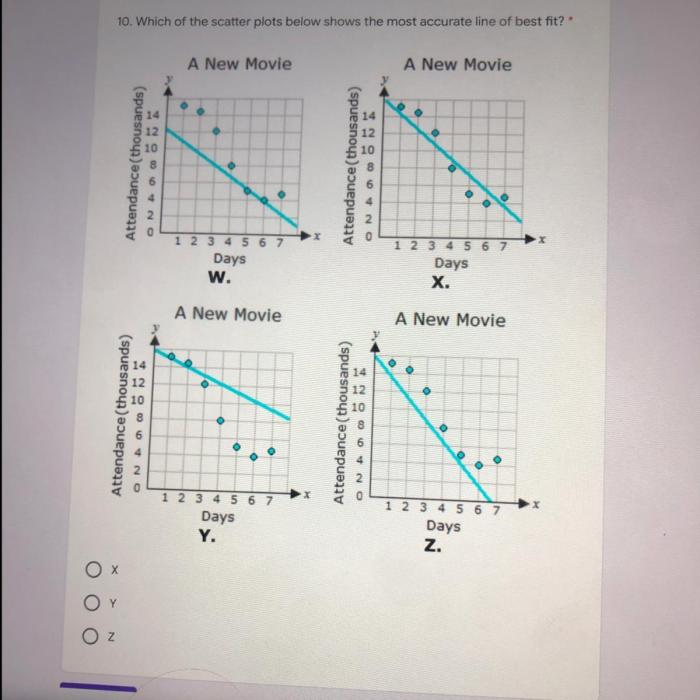Scatter plots and line of best fit matching answer key play a pivotal role in data analysis, offering valuable insights into relationships between variables. This comprehensive guide delves into the fundamentals of scatter plots, line of best fit determination, interpretation, and applications, providing a clear understanding of these essential statistical tools.
By presenting a step-by-step approach, this guide empowers individuals to effectively create and analyze scatter plots, determining the line of best fit with accuracy. It further explores the significance of slope, intercept, and correlation coefficient, enabling readers to draw meaningful conclusions from data.
1. Introduction to Scatter Plots and Line of Best Fit
A scatter plot is a graphical representation of the relationship between two variables. It is a collection of points plotted on a coordinate plane, where the x-axis represents one variable and the y-axis represents the other. The line of best fit is a straight line that is drawn through the points in the scatter plot in such a way that it minimizes the sum of the squared distances between the points and the line.
The line of best fit is a useful tool for understanding the relationship between two variables. It can be used to predict the value of one variable based on the value of the other, and it can also be used to determine whether there is a correlation between the two variables.
2. Creating a Scatter Plot

To create a scatter plot, you first need to gather data on two variables. Once you have your data, you can plot it on a coordinate plane. The x-axis should represent one variable, and the y-axis should represent the other.
There are different types of scatter plots. The most common type is the linear scatter plot, which shows a linear relationship between the two variables. Other types of scatter plots include the logarithmic scatter plot, which shows a logarithmic relationship between the two variables, and the exponential scatter plot, which shows an exponential relationship between the two variables.
3. Determining the Line of Best Fit

There are several methods for determining the line of best fit. The most common method is the least squares method, which minimizes the sum of the squared distances between the points and the line. Other methods include the median-median line method, which is less sensitive to outliers, and the orthogonal regression method, which is more robust to errors in the data.
The equation for the line of best fit is y = mx + b, where m is the slope of the line and b is the y-intercept.
4. Interpreting the Line of Best Fit
The slope of the line of best fit is a measure of the rate of change of the dependent variable with respect to the independent variable. A positive slope indicates that the dependent variable increases as the independent variable increases, while a negative slope indicates that the dependent variable decreases as the independent variable increases.
The y-intercept of the line of best fit is the value of the dependent variable when the independent variable is equal to zero. It is often used to predict the value of the dependent variable when the independent variable is known.
The correlation coefficient is a measure of the strength of the relationship between the two variables. It ranges from -1 to 1, where -1 indicates a perfect negative correlation, 0 indicates no correlation, and 1 indicates a perfect positive correlation.
5. Applications of Scatter Plots and Line of Best Fit: Scatter Plots And Line Of Best Fit Matching Answer Key

Scatter plots and the line of best fit are used in a wide variety of applications. They can be used to predict the value of one variable based on the value of another, to determine whether there is a correlation between two variables, and to model the relationship between two variables.
Some examples of real-world applications of scatter plots and the line of best fit include:
- Predicting the price of a house based on its square footage
- Determining whether there is a correlation between the amount of sleep a person gets and their academic performance
- Modeling the relationship between the temperature and the number of people who visit a beach
It is important to note that scatter plots and the line of best fit are only approximations of the relationship between two variables. They can be used to make predictions and to determine whether there is a correlation between two variables, but they cannot be used to prove that there is a causal relationship between two variables.
Quick FAQs
What is the purpose of a scatter plot?
A scatter plot visually represents the relationship between two variables, displaying data points as coordinates on a graph.
How do I determine the line of best fit?
The line of best fit can be determined using methods such as linear regression, which minimizes the sum of squared residuals between the data points and the line.
What does the slope of the line of best fit indicate?
The slope represents the rate of change in the dependent variable for a unit change in the independent variable.